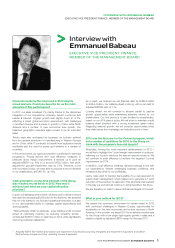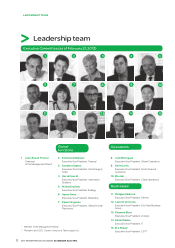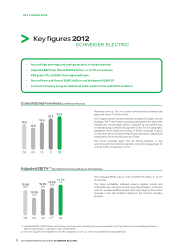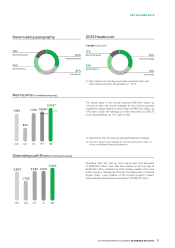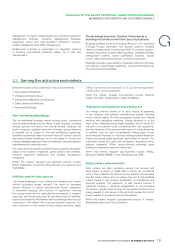APC 2012 Annual Report Download - page 17
Download and view the complete annual report
Please find page 17 of the 2012 APC annual report below. You can navigate through the pages in the report by either clicking on the pages listed below, or by using the keyword search tool below to find specific information within the annual report.
2012 REGISTRATION DOCUMENT SCHNEIDER ELECTRIC 15
OVERVIEW OF THEGROUP’S STRATEGY, MARKETS AND BUSINESSES
1
OUR STRATEGY AND MARKET OPPORTUNITIES
A smarter grid combines smarter supply (the effi cient integration
of renewable energy sources, fl exible distribution), smarter demand
(energy-effi cient sites and homes, connected to the grid), and
demand response to balance the two.
Schneider Electric is active in fi ve key domains of the smart grid:
fl exible distribution, renewable energy integration, effi cient buildings,
electric vehicle charging infrastructure and demand-response.
Recent acquisitions have considerably strengthened our play –from
Areva’s Distribution business to Energy Pool and Vizelia in2010 and
Summit Energy and Telvent in2011.
Cities, at the heart of the sustainability battle
Cities today contain 50% of the world’s population, consume 75%
of global energy consumption and give off 80% of greenhouse gas
emissions. And cities are growing: by 2050, they will be home to
70% of the people in the world. Cities face urban challenges of
unprecedented scale: scarcity of resources such as energy and
water; environmental pressure and pollution; aging and overloaded
infrastructure; traffi c congestion; crime, etc.
All over the world, cities need to become smarter: more efficient,
more liveable and more sustainable. This means:
•improving the effi ciency of the city’s underlying urban
infrastructures (electricity grid, gas distribution system, water
distribution system, public transportation systems, public
services, commercial buildings, hospitals, homes,etc);
•becoming a better place to live, work and play;
•reducing its environmental impact – lower carbon footprint, urban
regeneration, parks and trees, etc.
So what cities need today are solutions to their most acute pain-
points that: deliver the short-term results that constituents need;
provide visible, measurable results that increase attractiveness; and
have a low upfront investment, because cities across the world
need to balance their budget.
Schneider Electric delivers urban efficiency by bringing in
technology with tried and tested solutions and by working on
the integration of operating systems and information systems. As
cities involve many stakeholders –local and regional governments,
private companies, utilities, real estate developers, investors, etc.–
Schneider Electric drives collaboration to ensure buy-in of all these
stakeholders.
Schneider Electric already works with more than 200cities across
the world, and helps provide visible benefi ts to cities and their
constituents:
•up to 30% energy savings;
•up to 15% reduction of water losses;
•up to 20% reduction of travel time and traffi c delays;
•as well as environmental, social and economic benefi ts.
Accelerated growth in new economies
Non-OECD economies represented about 35% of global GDP
in2011 and may reach close to 60% by 2030. Their share of global
energy demand will continue to rise –from 55% in2010 to close
to 65% by 2035 – because of demographics, industrialisation,
urbanisation, and growing affl uence.
Millions of men, wome n and children will see their living standards
rise: while today 1.3billion people lack access to energy (20% of
the world’s population), this number will fall to 990million in2030,
or 12% of global population.
These dramatic shifts will change our world. In economic terms, it
means that new economies are the drivers of global growth –and
this trend should continue for years to come.
In order to benefi t from this growth lever, Schneider Electric has
built a signifi cant presence in these new economies, holding strong
positions in Asia , Africa, the Middle East, Latin America, Eastern
Europe and Russia.
1.3 Our strategy
Leverage the world’s new energy challenges
The world’s energy challenges are many: growth in energy demand,
energy price increases, scarcity of natural resources, CO2 emissions
reduction requirements, integration of unpredictable and intermittent
renewable sources of energy, increases in peaks of consumption
and others. We have developed a wide range of products and
solutions that will provide managers of industrial plants, data
centers, infrastructure, homes and buildings with signifi cant levels
of energy effi ciency and savings. Our smart grid solutions help
electricity producers and distributors to improve the effi ciency of
their assets and to offer a better service to their consumers. This
also contributes to the improvement in the operation of the grid and
the reduction in investment in new generation capacity.
Build two complementary business models:
Products and Solutions
Products and solutions are different and complementary business
models and we aim to deliver profi table growth in both. In order to
reinforce our leadership positions, we continue to target growth in
our products business by creating new opportunities for distributors
and direct partners in a win-win relationship. We are also focused on
growing our solutions business by increasing our service revenues
and reinforcing project execution. We have developed reference
architectures for solutions in targeted end-markets in order to
facilitate smooth integration of our products and speed up project
design. We are also deploying a unifi ed software suite to support
the deployment of solutions.


